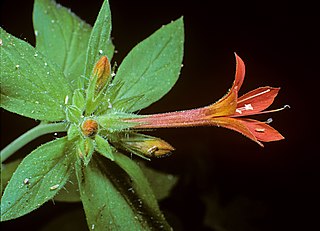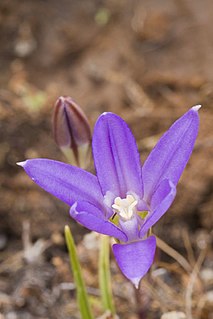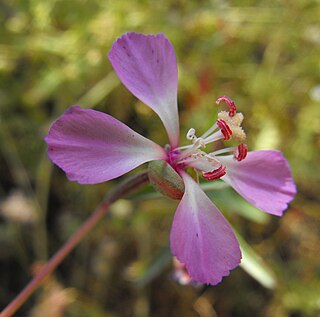
Brodiaea, also known by the common name cluster-lilies, is a monocot genus of flowering plants.

Hooveria purpurea is a species of flowering plant related to the agaves known by the common name purple amole. This species of soap plant is endemic to California, where it grows in the Santa Lucia Range, in the Central Coast region. There are two varieties of this plant, and both are believed to be quite rare. It is a federally listed threatened species.

Clematis pauciflora is a species of clematis known by the common name ropevine. This flowering plant is native to the high desert and chaparral slopes of southern California and Baja California. It is a woody vine with nodes every few centimeters which produce leaves and flowers. The leaves are made up of several dark green lobed leaflets, each one to three centimeters wide. From each leaf-bearing node grows an inflorescence of one to three flowers with narrow petallike sepals in shades of light yellow. Most of the flower is made up of a spray of up to 50 stamens and almost as many similar-looking pistils. The fruit is an achene equipped with a long plume-like style. The specific epithet pauciflora is Latin for 'few-flowered'.

Collomia rawsoniana is a species of flowering plant in the phlox family known by the common name flaming trumpet. This perennial wildflower is endemic to California, where it is known from only two counties: Mariposa and Madera. It grows in the woodland understory in the Sierra Nevada foothills. This plant produces a thin, erect stem to about half a meter in height with widely spaced, deeply toothed hairy leaves each several centimeters long. Atop the stem is an inflorescence of three to seven showy red-orange flowers. Each flower is up to 4 centimeters long and trumpet-shaped, with a protruding pistil and stamens tipped with anthers covered in blue pollen.

Fritillaria ojaiensis is a rare species of fritillary known by the common name Ojai fritillary.

Keckiella corymbosa is a species of flowering shrub in the plantain family known by the common names redwood keckiella, red beardtongue, and red shrubby penstemon.

Brodiaea coronaria is the type species of Brodiaea and also known by the common names harvest brodiaea and crown brodiaea. It is native to western North America from British Columbia to northern California, where it grows in mountains and grasslands.

Brodiaea elegans is a species of flowering plant in the cluster-lily genus known by the common names harvest brodiaea, elegant brodiaea, and elegant cluster-lily.

Brodiaea filifolia, known by the common name threadleaf brodiaea, is a rare species of flowering plant in the cluster-lily genus. It is endemic to southern California, mostly in the region around the junction of Orange, Riverside, and San Diego Counties.
Brodiaea insignis is a rare species of flowering plant in the cluster-lily genus known by the common name Kaweah brodiaea. It is endemic to the Sierra Nevada foothills of central Tulare County, California, where it grows along the Tule and Kaweah Rivers. It is considered endangered on the state level.

Brodiaea jolonensis, known by the common name chaparral brodiaea, is a species of flowering plant in the cluster-lily family.
Brodiaea orcuttii is a species of flowering plant in the family Asparagaceae, subfamily Brodiaeoideae. It is a cluster-lily known by the common name Orcutt's brodiaea. The bulb is native to Southern California, mainly San Diego County, where it is an uncommon species. Its range probably extends into Baja California.

Brodiaea pallida is a rare species of flowering plant in the cluster-lily genus known by the common name Chinese Camp brodiaea.
Brodiaea stellaris is a species of flowering plant in the cluster-lily genus known by the common name starflower brodiaea.
Clarkia borealis is a rare species of flowering plant in the evening primrose family known by the common name northern clarkia. It is endemic to California, where it is known from the forests of the southern Klamath Range and the southernmost Cascade Range foothills. It is an annual herb growing an erect, slender stem. The leaves are oval in shape and borne on short petioles. The top of the stem is occupied by the inflorescence, in which the lowest flowers open first and hanging, pointed flower buds occur at nodes at the top. The sepals separate as the flower blooms, revealing purplish pink petals. Each petal is between 1 and two centimeters long, elongated triangular to semicircular in shape, and sometimes flecked with dark purple. There are 8 stamens with anthers bearing blue-gray pollen, and a protruding stigma.

Clarkia delicata is a rare species of flowering plant in the evening primrose family known by the common names Campo clarkia and delicate clarkia. It is native to northern Baja California and adjacent San Diego County, California, where it grows in the woodland and chaparral of the Peninsular Ranges. This is an annual herb producing an erect stem just over half a meter in maximum height. The leaves are oval or widely lance-shaped, up to 4 centimeters long, and borne on very short petioles. The top of the stem is occupied by the inflorescence, in which the lower flowers open while the upper buds hang closed. The sepals remain fused as the flower blooms from one side. Each unlobed oval petal is about a centimeter long and pink to pinkish-lavender. There are 8 stamens, some with large orange anthers and some with smaller, paler anthers. There is also a protruding stigma with four large, fuzzy lobes.

Clarkia mildrediae is an uncommon species of flowering plant in the evening primrose family known by the common name Mildred's clarkia. It is endemic to California, where it is known from the forests of the southernmost Cascade Range and northern Sierra Nevada. It is an erect annual herb often exceeding half a meter in height. The oval leaves grow up to 6 centimeters long and are borne on petioles of up to 4 centimeters. The inflorescence bears opening flowers and hanging, pointed flower buds. As the bud opens the sepals all separate instead of remaining fused as those of many other Clarkia species do. The triangular to semicircular petals are about 2 centimeters long and lavender to bright reddish-purple, sometimes with dark speckling. There are 8 stamens with anthers all alike, and a protruding stigma.

Clarkia virgata is a species of flowering plant in the evening primrose family known by the common name Sierra clarkia. It is endemic to California, where it is known from the forests and woodlands of the Sierra Nevada.
Brodiaea santarosae is a rare Brodiaea species known by the common name Santa Rosa brodiaea and Santa Rosa Basalt brodiaea. It is endemic to southern California, mostly in the region around the junction of Orange, Riverside, and San Diego Counties and limited to ancient basaltic soils. There are only five known populations. It was once thought to be an intergrade of Brodiaea filifolia and B. orcuttii, but measurements found this to be false. It was described as a new species in 2007.

Triteleia hyacinthina is a species of flowering plant known by the common names white brodiaea, white tripletlily, hyacinth brodiaea, and fool's onion. It is native to western North America from British Columbia to Idaho to central California. Its habitat includes grassland and vernally moist areas such as meadows and vernal pools. It is a perennial herb growing from a corm. It produces two or three basal leaves up to 40 centimeters (16 in) long by 2 centimeters (0.79 in) wide. The inflorescence arises on an erect stem up to 60 centimeters (24 in) tall and bears an umbel-like cluster of many flowers. Each flower is a funnel-shaped bloom borne on a pedicel up to 5 centimeters (2.0 in) long. The flower is white, often tinged purple along the tubular throat, with six green-veined tepals. There are six stamens with white, yellow, or occasionally blue anthers.
















